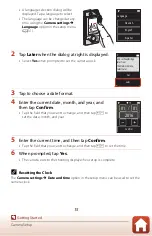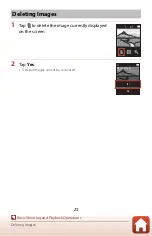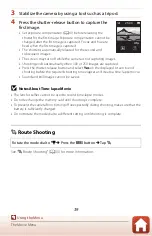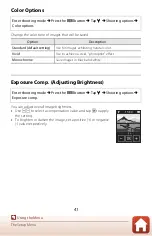
28
Basic Operations of Movie Recording and Movie Playback
Maximum Movie Recording Time
Individual movie files cannot exceed 4 GB in size or 29 minutes in length, even when
there is sufficient free space on the memory card for longer recording.
•
The remaining recording time for a single movie is displayed on the shooting
screen.
•
Recording may end before either limit is reached if camera temperature becomes
elevated.
•
The actual remaining recording time may vary depending on the movie content,
subject movement, or type of memory card.
•
Memory cards with an SD Speed Class rating of 6 or faster are recommended when
recording movies (
83). Movie recording may stop unexpectedly when a
memory card with a lower Speed Class rating is used.
B
Camera Temperature
•
The camera may become hot when recording movies for an extended period of time or
when the camera is used in a hot area.
•
If the inside of the camera becomes extremely hot when recording movies, the camera
will automatically stop recording.
After the camera stops recording, it turns itself off.
Leave the camera off until the inside of the camera has cooled.
Notes About Movie Recording
B
Notes About Saving Images or Movies
The message
Please wait for the camera to finish recording.
is displayed while images
or movies are being saved.
Do not open the memory card slot/connector cover or
remove the memory card
. Doing this could result in loss of data, or in damage to the
camera or the memory card.
B
Notes About Recorded Movies
•
The following phenomena may be seen on the screen while recording movies. These
phenomena are saved in the recorded movies.
- Banding may occur in images under fluorescent, mercury-vapor, or sodium-vapor
lighting.
- Subjects that move quickly from one side of the frame to the other, such as a moving
train or car, may appear skewed.
- The entire movie image may be skewed when the camera is panned.
- Lighting or other bright areas may leave residual images when the camera is moved.
•
Depending on the distance to the subject, colored stripes may appear on subjects with
repeating patterns (fabrics, lattice windows, etc.) during movie recording and playback.
This occurs when the pattern in the subject and the layout of the image sensor interfere
with each other; it is not a malfunction.















































